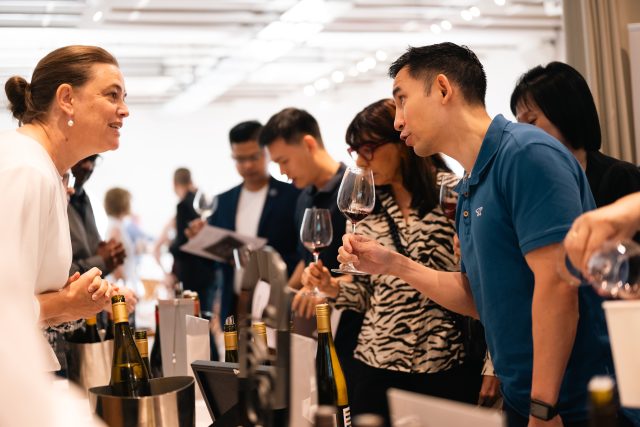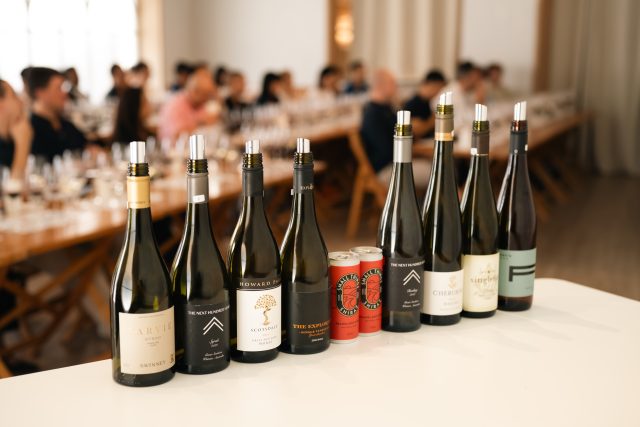Western Australia’s Great Southern wine region may not be the area on everyone’s lips just yet, but a recent masterclass revealed that it’s staking an assured claim on the Singapore wine landscape. Nimmi Malhotra reports.

Sprawling across the southern belt of Western Australia, the Great Southern is vast, remote, and ancient – a landscape defined by its isolation and diversity. The region encompasses five distinct subregions and holds the title of the country’s largest geographical indication (GI). Yet, for all its size, it remains one of Australia’s lesser-known wine regions.
That may be starting to change. A delegation of eight producers recently arrived in Singapore to introduce their wines to the local trade, bringing with them a curated selection that showcased the region’s hallmark varieties: Riesling and Shiraz.
“If you haven’t heard of Great Southern, it shouldn’t be a surprise,” said Patrick Corbett, managing director of Singlefile Wines, as he set the stage for the regional masterclass along with industry colleague Mike Garland, seasoned winemaker of Fervor Wines.
To their surprise – and that of the visiting delegates from the Great Southern region – some attendees had ventured south to explore the area first-hand. The proximity of Western Australia to Singapore works in its favour. Others, including a packed room of sommeliers, buyers, and select members of the international wine fraternity gathered for Vinexpo Asia, came armed with curiosity and enthusiasm to learn more.
The region takes shape
The Great Southern region stretches 100km from north to south and 150km east to west, encompassing the subregions of Albany, Denmark, Frankland River, Mount Barker and Porongurup.
Agriculture dominates more than half of the land, while the rest is blanketed in native forests, woodlands and heath, boasting outstanding botanical diversity. Vineyards cover 23 square kilometres of the 40,000 sq kms in the region.
 Great Southern wines are gaining international recognition
Great Southern wines are gaining international recognition
Travelling between vineyards can take an hour or more, though the journey winds through ancient jarrah, karri, and marri trees. The terrain shifts from the cool, coastal sites of Albany and Denmark to the warmer, inland vineyards of Frankland River and Mount Barker. Porongurup — the smallest — stands apart: elevated, botanically rich and home to some of the longest ripening seasons in the region.
Garland, who has spent more than two decades making wine in the region, first at the renowned Plantagenet Wines and now at his own label, Fervor Wines, reflected on the region’s origins. Unlike Margaret River, “the Great Southern was founded by farmers, not doctors”, he said, noting how locals initially planted vines to diversify their livelihoods.
At the time, there was little formal research to guide vineyard planting. He added: “In some instances, we nailed the right variety with the right site. In other places, we got it wrong. Now, some 40 years later, we actually can recognise which of the varieties grow particularly well.”
Today, the Denmark area is predominantly planted with Riesling and Chardonnay. Most of the vineyards in Porongurup’s northeast slopes favour Pinot Noir and Riesling.
Further inland, Frankland River and Mount Barker are well-suited for late-ripening grapes like Shiraz, Grenache, and Cabernet Sauvignon.
 Nine wines were tasted throughout the masterclass
Nine wines were tasted throughout the masterclass
The measure of Great Southern Rieslings
Four Rieslings featured as part of the masterclass: Fervor Dokta Nova Riesling 2024; Singlefile Great Southern Riesling 2024; Cherubino Frankland River Riesling 2023; and The Next Hundred Years Riesling 2023.
The line-up revealed a clear identity – bone dry, precise, and bristling with acidity. It was inevitable that the wines should be compared with those from the Eden Valley and Clare Valley.
Garland didn’t hesitate to offer a perspective of how climate change is tilting the balance.
He argued that both the South Australian regions are becoming too hot for Riesling. “Eden Valley and Clare Valley are placing huge emphasis on their site selection, planting on southern slopes with the least amount of sun exposure and getting bigger canopies to make sure that they don’t get that sun exposure,” he said.
“Fortunately for us, a little bit of climate change is actually pretty handy. Our sites are far cooler. We have a far greater retention of natural acidity than Eden and Clare Valley, and we are quite distinctly different.”
He believes the real difference will be apparent with age. “I’m obviously partial to my region, but I think our wines stand up well to any of those regions.”
 Singapore’s wine trade showed up en masse to taste the wines
Singapore’s wine trade showed up en masse to taste the wines
Shiraz or Syrah?
Among the five red wines, five Syrah/Shiraz expressions were poured at the masterclass. Of these, three expressions were labelled as Shiraz: Small Things Frankland River Shiraz 2022; 3 Oceans The Explorers Single Vineyard Shiraz 2022; and Howard Park Scotsdale Shiraz 2022. Another two were named Syrah: The Next Hundred Years Syrah 2022, and Swinney ‘Farvie’ Frankland River Syrah 2023.
It was evident that the region’s signature red comes in two styles, where Shiraz refers to the rich Barossa style and Syrah references a style more reminiscent of the Northern Rhône.
Garland explained the distinction: “Our wines are different from the rest of Australia,” he said. “We’re not Barossa, but we’re not Rhône either. We get plenty of sunshine, and will always produce richer and fuller wines. However, stylistically and structurally, they align more closely with the Rhône.”
Beyond the flagships
The free-pour session following the masterclass underscored the region’s diversity, with samples of Cabernet Sauvignon, Grenache, Malbec and even Nebbiolo. Singlefile Wines’ Corbett noted that while it is common to lead a new region with a flagship variety, the other grapes are showing great promise. The Cabernet Sauvignon stood tall as a close second, if not an alternative first.
Another topic that arose from the audience related to pricing. Where some felt the prices were quite competitive, others did not. Corbett argued that it is worth comparing the price and quality of these wines with international expressions when making a judgement. “I think when you start putting those wines on the international stage, they all show significant value,” he said simply.
The Great Southern region faces its share of challenges, as any new region would.
The biggest challenge, according to Terry Chellappah, founder of Plan B! and The Next Hundred Years, is to raise awareness for the area. He said: “Not enough people know about us and our wine styles. We’ve been very proactive in the last few years, and we have more to do.”
Related news
EU General Court blocks ‘Nero Champagne’ trademark
Opus One earns prestigious Butterfly Mark
La grande boucle en vins: Tour de France 2025 wine pairings

